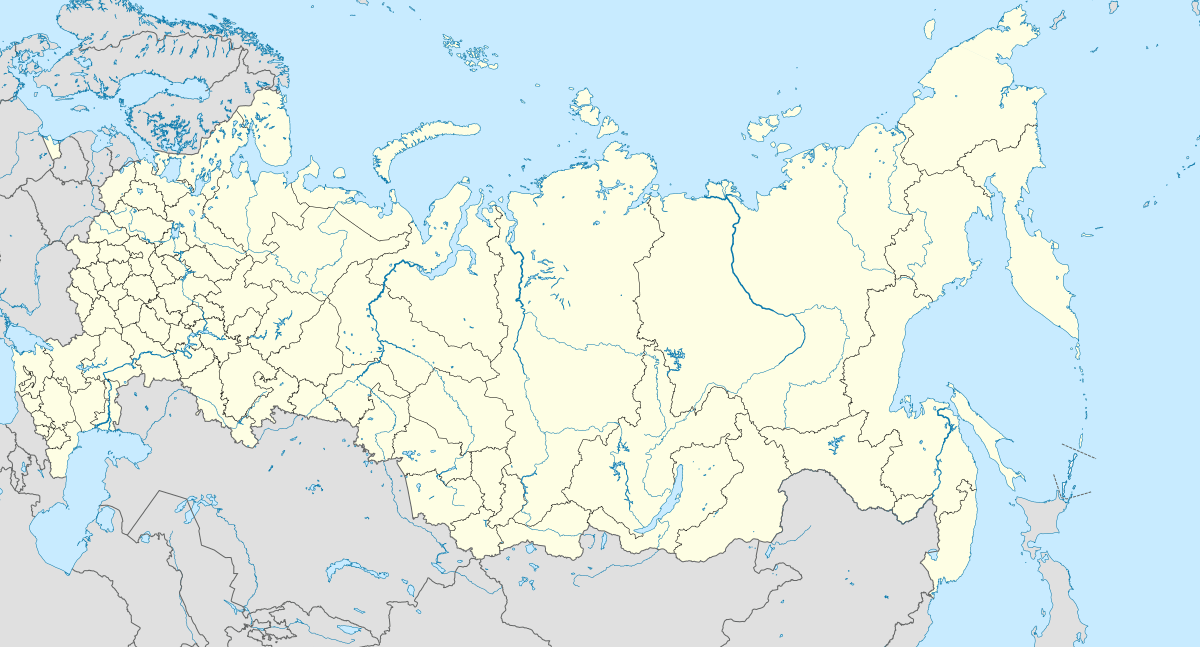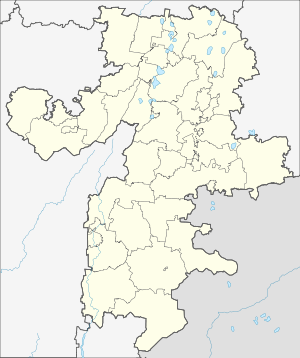Zlatoust
Zlatoust (Russian: Златоуст, IPA: [zlətɐˈust]) is a city in Chelyabinsk Oblast, Russia, located on the Ay River (in the Kama basin), 160 kilometers (99 mi) west of Chelyabinsk. Population: 174,962 (2010 Census);[1] 194,551 (2002 Census);[6] 207,794 (1989 Census);[7] 181,000 (1971); 161,000 (1959); 99,000 (1939); 48,000 (1926); 21,000 (1910).
Zlatoust Златоуст | |
|---|---|
City | |
.jpg) New Year's Square, Zlatoust | |
.png) Flag .png) Coat of arms | |
Location of Zlatoust 
| |
 Zlatoust Location of Zlatoust  Zlatoust Zlatoust (Chelyabinsk Oblast) | |
| Coordinates: 55°10′N 59°40′E | |
| Country | Russia |
| Federal subject | Chelyabinsk Oblast |
| Founded | 1754 |
| Government | |
| • Mayor | Maxim Pekarsky |
| Elevation | 125 m (410 ft) |
| Population | |
| • Total | 174,962 |
| • Estimate (2018)[2] | 166,885 (-4.6%) |
| • Rank | 103rd in 2010 |
| • Subordinated to | City of Zlatoust[3] |
| • Capital of | City of Zlatoust[3] |
| • Urban okrug | Zlatoustovsky Urban Okrug[3] |
| • Capital of | Zlatoustovsky Urban Okrug[3] |
| Time zone | UTC+5 (MSK+2 |
| Postal code(s)[5] | 456200 |
| Dialing code(s) | +7 3513 |
| OKTMO ID | 75712000001 |
| Website | www |
Etymology
Apparently, the city's name is derived from the Russian translation of "Chrysostom", literally "golden-mouthed" in the original Greek, for the eloquent Saint John Chrysostom,[8] because the city was founded near a church dedicated to that saint.
History


Zlatoust was founded in 1754 due to the construction of the ironworks.[9] In 1774–76, the workers of the plant took part in the insurrection led by Yemelyan Pugachev. In the early 19th century, Pavel Anosov made the first Russian bulat steel blades in Zlatoust. It was granted town status in 1865. From 1865 to 1919 Zlatoust was part of Ufa Governorate. The town is also known for the first cannons made of Russian steel. In 1903, the Tsarist authorities brutally suppressed a strike, organized by the workers of Zlatoust.
In 1815, an arms factory was built here, which began to produce sabres and swords.[10] To establish production, more than a hundred experts were invited from renowned arms centers in Europe, including Solingen and Klingenthal (Germany). In summer 1816, the first batch of Zlatoust blades was sent to Saint-Petersburg, both combat weapons and decorated samples.[10] Famous artists Ivan Bushuyev and Ivan Boyarshinov authored unique patterns of cold-steel decorated with engravings. Bushuyev's and Boyarshinov's swords are very rare; under 2 dozen are believed to exist today, all in Russian state museums and wealthy Russians' collections (rare published example). The flying winged horse was a favorite element of many of Bushuyev's engravings, so he was given a nickname Ivan the Wingy (Ivanko Krylatko). Since then, a pegasus has been an emblem of the town. The Soviets gained control over Zlatoust in March 1918. The town was occupied by the Whites between June 1918 and July 1919. On 13 July 1919, Zlatoust was seized by the Red Army.
During the Soviet period, Zlatoust became an industrial city, which specialized in metallurgy, mechanical engineering, tool-making, food production, and other industries. Zlatoust is one of the centers of artistic engraving on metal in Russia. Traditionally, such engravings were done on weapons, such as knives and swords; however, during the Soviet period, the engraving was shifted onto decorative metal plates. Nowadays the weapon engraving is popular again.
2013 meteor event
Administrative and municipal status
Within the framework of administrative divisions, it is, together with nine rural localities, incorporated as the City of Zlatoust—an administrative unit with the status equal to that of the districts.[3] As a municipal division, the City of Zlatoust is incorporated as Zlatoustovsky Urban Okrug.[3]
Notable natives or residents
- Boris Shaposhnikov, Marshal of the Soviet Union
- Lidiya Skoblikova, Olympic winning speed-skater
- Anatoly Karpov, former world chess champion
- Svetlana Ishmouratova, 2006 Olympic Gold Medalist biathlete
- Alexander Mordukhovich, composer
- Yuri Mikhailovich Vyshinsky, filmmaker and screenwriter
References
Notes
- Russian Federal State Statistics Service (2011). "Всероссийская перепись населения 2010 года. Том 1" [2010 All-Russian Population Census, vol. 1]. Всероссийская перепись населения 2010 года [2010 All-Russia Population Census] (in Russian). Federal State Statistics Service.
- "26. Численность постоянного населения Российской Федерации по муниципальным образованиям на 1 января 2018 года". Federal State Statistics Service. Retrieved January 23, 2019.
- Resolution #161
- "Об исчислении времени". Официальный интернет-портал правовой информации (in Russian). June 3, 2011. Retrieved January 19, 2019.
- Почта России. Информационно-вычислительный центр ОАСУ РПО. (Russian Post). Поиск объектов почтовой связи (Postal Objects Search) (in Russian)
- Russian Federal State Statistics Service (May 21, 2004). "Численность населения России, субъектов Российской Федерации в составе федеральных округов, районов, городских поселений, сельских населённых пунктов – районных центров и сельских населённых пунктов с населением 3 тысячи и более человек" [Population of Russia, Its Federal Districts, Federal Subjects, Districts, Urban Localities, Rural Localities—Administrative Centers, and Rural Localities with Population of Over 3,000] (XLS). Всероссийская перепись населения 2002 года [All-Russia Population Census of 2002] (in Russian).
- "Всесоюзная перепись населения 1989 г. Численность наличного населения союзных и автономных республик, автономных областей и округов, краёв, областей, районов, городских поселений и сёл-райцентров" [All Union Population Census of 1989: Present Population of Union and Autonomous Republics, Autonomous Oblasts and Okrugs, Krais, Oblasts, Districts, Urban Settlements, and Villages Serving as District Administrative Centers]. Всесоюзная перепись населения 1989 года [All-Union Population Census of 1989] (in Russian). Институт демографии Национального исследовательского университета: Высшая школа экономики [Institute of Demography at the National Research University: Higher School of Economics]. 1989 – via Demoscope Weekly.
- "St. John Chrysostom". The Catholic Encyclopedia. New Advent. Retrieved November 19, 2017.
- "Weapons Cabinet in the Arsenal Museum of the Zlatoust Plant". www.wdl.org. 1910. Retrieved January 7, 2020.
- "HISTORY". Pegasus Leaders. Retrieved January 7, 2020.
Sources
- Законодательное Собрание Челябинской области. Постановление №161 от 25 мая 2006 г. «Об утверждении перечня муниципальных образований (административно-территориальных единиц) Челябинской области и населённых пунктов, входящих в их состав», в ред. Постановления №2255 от 23 октября 2014 г. «О внесении изменений в перечень муниципальных образований (административно-территориальных единиц) Челябинской области и населённых пунктов, входящих в их состав». Вступил в силу со дня официального опубликования. Опубликован: "Южноуральская панорама", №111–112, 14 июня 2006 г. (Legislative Assembly of Chelyabinsk Oblast. Resolution #161 of November 25, 2006 On Adoption of the Registry of the Municipal Formations (Administrative-Territorial Units) of Chelyabinsk Oblast and of the Inhabited Localities They Comprise, as amended by the Resolution #2255 of October 23, 2014 On Amending the Registry of the Municipal Formations (Administrative-Territorial Units) of Chelyabinsk Oblast and of the Inhabited Localities They Comprise. Effective as of the official publication date.).